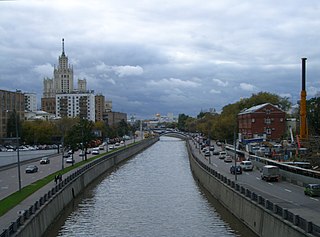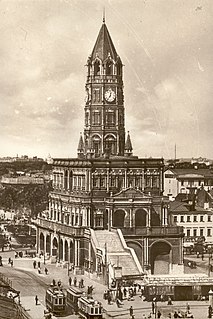
The Neva is a river in northwestern Russia flowing from Lake Ladoga through the western part of Leningrad Oblast to the Neva Bay of the Gulf of Finland. Despite its modest length of 74 kilometres (46 mi), it is the fourth-largest river in Europe in terms of average discharge.

The Moskva is a river running through western Russia. It rises about 140 km (90 mi) west of Moscow and flows roughly east through the Smolensk and Moscow Oblasts, passing through central Moscow. About 110 km (70 mi) southeast of Moscow, at the city of Kolomna, it flows into the Oka, itself a tributary of the Volga, which ultimately flows into the Caspian Sea.

The Pontcysyllte Aqueduct is a navigable aqueduct that carries the Llangollen Canal across the River Dee in the Vale of Llangollen in northeast Wales.

The Falkirk Wheel is a rotating boat lift in Tamfourhill, Falkirk, in central Scotland, connecting the Forth and Clyde Canal with the Union Canal. It reconnects the two canals for the first time since the 1930s. It opened in 2002 as part of the Millennium Link project.

The Yauza is a river in Moscow and Mytishchi, Russia, a tributary of the Moskva. It originates in the Losiny Ostrov National Park northeast of Moscow, flows through Mytishchi, enters Moscow in the Medvedkovo District and flows through the city in an irregular, meandering, generally north-south direction. The Yauza joins the Moskva River in Tagansky District just west of Tagansky Hill, now marked by the Kotelnicheskaya Embankment tower. Valleys of the Yauza, from the MKAD beltway in the north to the Moscow-Yaroslavl railway west of Sokolniki Park, are protected as natural reserves.

The Fontanka, a left branch of the river Neva, flows through the whole of Central Saint Petersburg, Russia – from the Summer Garden to Gutuyevsky Island. It is 6.7 kilometres (4.2 mi) long, with a width up to 70 metres (230 ft), and a depth up to 3.5 metres (11 ft). The Moyka River forms a right-bank branch of the Fontanka. Lined along the Fontanka Embankment stand the former private residences of Russian nobility.

The Sukharev Tower was a Moscow landmark until its destruction by Soviet authorities in 1934. Tsar Peter I of Russia had the tower built in the Moscow baroque style at the intersection of the Garden Ring with Sretenka Street in 1692–1695.

Mytishchi is a city and the administrative center of Mytishchinsky District in Moscow Oblast, Russia, which lies 19 km northeast of Russia's capital Moscow on the Yauza River and the Moscow–Yaroslavl railway. The city was an important waypoint for traders on the Yauza River, the Yaroslavl Highway passes through the city. Mytishchi is famous for its aqueduct, built in 1804, the first water supply pipeline to supply the growing population of Moscow. The city has a population of approximately 262,702 people as of 2022.

The New Croton Dam is a dam forming the New Croton Reservoir, both parts of the New York City water supply system. It stretches across the Croton River near Croton-on-Hudson, New York, about 22 miles (35 km) north of New York City.

Navigable aqueducts are bridge structures that carry navigable waterway canals over other rivers, valleys, railways or roads. They are primarily distinguished by their size, carrying a larger cross-section of water than most water-supply aqueducts. Roman aqueducts were used to transport water and were created in Ancient Rome. The 662-metre (2,172 ft) long steel Briare aqueduct carrying the Canal latéral à la Loire over the River Loire was built in 1896. It was ranked as the longest navigable aqueduct in the world for more than a century, until the Magdeburg Water Bridge in Germany took the title in the early 21st century.

The Moscow Canal, named the Moskva-Volga Canal until 1947, is a canal in Russia that connects the Moskva River with the Volga River. It is located in Moscow itself and in the Moscow Oblast. The canal connects to the Moskva River in Tushino, from which it runs approximately north to meet the Volga River in the town of Dubna, just upstream of the dam of the Ivankovo Reservoir. The length of the canal is 128.1 kilometres (79.6 mi).

Vodootvodny Canal is a 4 kilometre long, 30-60 metre wide canal in downtown Moscow, Russia. It was built in the 1780s on the old riverbed of the Moskva River to control floods and support shipping. Canal construction created an island between the Moskva River and the canal. The island acquired its present shape in 1938 with the completion of Moscow Canal megaproject. The canal is spanned by ten bridges; the eleventh is now under construction.

The Store Street Aqueduct in central Manchester, England, was built in 1798 by Benjamin Outram on the Ashton Canal. A Grade II* listed building it is built on a skew of 45° across Store Street, and is believed to be the first major aqueduct of its kind in Great Britain and the oldest still in use today.
Bolshoy Ustinsky Bridge is a steel arch bridge that spans Moskva River near the mouth of Yauza River, connecting the Boulevard Ring with Zamoskvorechye district in Moscow, Russia. It was completed in May 1938 by V.M.Vakhurkin, G.P.Golts and D.M.Sobolev.

The Moscow Orphanage or Foundling Home was an ambitious project conceived by Catherine the Great and Ivan Betskoy, in the early 1760s. This idealistic experiment of the Age of Enlightenment was intended to manufacture "ideal citizens" for the Russian state by bringing up thousands of abandoned children to a very high standard of refinement, cultivation, and professional qualifications. Despite more than adequate staffing and financing, the Orphanage was plagued by high infant mortality and ultimately failed as a social institution.

Preobrazhenskiy Metro Bridge is the shortest of four rail bridges in Moscow, Russia. It is located in the Eastern Administrative Okrug of the city. It spans over Yauza River and is a part of the Sokolnicheskaya Line of Moscow Metro. It connects the stations Preobrazhenskaya Ploshchad and Sokolniki.

The Ligovsky Canal is one of the longest canals of Saint Petersburg (Russia). Constructed in 1721, it is 23 kilometres (14 mi) long. Its purpose was to supply water for the fountains of the Summer Garden. The canal delivered water from the Liga River, now called the Dudergofka to ponds on the current Nekrasov Street.

The Yaroslavsky suburban railway line is one of eleven railway lines used for suburban railway connections between Moscow, Russia, and surrounding areas, mostly in Moscow Oblast. The Yaroslavsky suburban railway line connects Moscow with the stations in the northeast, in particular, with the towns of Mytishchi, Korolyov, Ivanteyevka, Fryazino, Shchyolkovo, Pushkino, Krasnoarmeysk, Sergiyev Posad, Strunino, and Alexandrov. The stations the line serves are located in Moscow, as well as in the towns of Mytishchi, Kaliningrad, Shchyolkovo, Ivanteyevka, Fryazino, Noginsk, Pushkino, Krasnoarmeysk, and Sergiyev-Posad in Moscow Oblast, as well as Alexandrovsky District of Vladimir Oblast. The suburban trains have their southwestern terminus at Moscow Yaroslavsky railway station in Moscow. In the northeastern direction, the suburban trains terminate at Bolshevo, Fryazino Passazhirskaya, Monino, Shchyolkovo, Fryazevo, Pushkino, Sofrino, Krasnoarmeysk, Sergiyev Posad, Alexandrov, and Balakirevo. The line is served by the Moscow Railway subsidiary of Russian Railways and the Central Suburban Passenger Company.
















